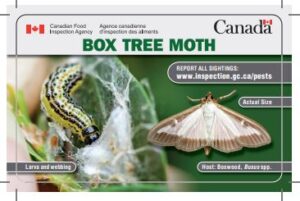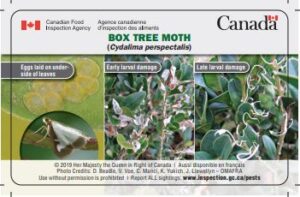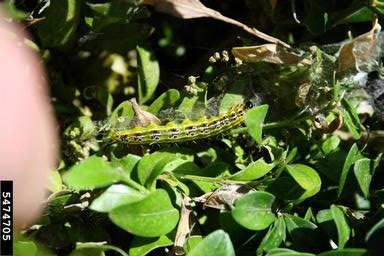Box Tree Moth (Cydalima perspectalis)
French common name: Pyrale du buis

Box Tree Moth - Brown Colour Variant
Photo credit: Szablocs Sáfián, University of West Hungary, Bugwood.org

Box Tree Moth - White Colour Variant
Szablocs Sáfián, University of West Hungary, Bugwood.org
Order: Lepidoptera
Superfamily: Pyraloidea
Family: Crambidae
The Box Tree Moth (Cydalima perspectalis; BTM) is a pest insect native to Asia. It has become an invasive species in much of Europe, and more recently in North America. BTM was first documented in North America in August 2018 by a community scientist on iNaturalist in Toronto, Ontario. Since it’s introduction, it has spread within Canada to Quebec, New Brunswick, Nova Scotia, Prince Edward Island, and Newfoundland and Labrador, as well as spreading to the United States, having been confirmed in South Carolina, Connecticut, and Michigan.
BTM poses a major threat to boxwood (Buxus spp.), a genus of common horticultural shrub in Canada. Most damage occurs as the larvae feed on the boxwood, causing defoliation and dieback of the host.

Photo credit: CFIA
Eggs: Usually laid on the underside of boxwood (Buxus spp.) leaves in clusters of 10 – 20. They start off a translucent greenish yellow, and over about 3 days of development, their black heads become visible through the egg.
Larva: Light green caterpillar with black and white stripes, black dots, and a black head. They go through up to 7 larval instars over the course of about 2 weeks and can reach 4 cm long.

Photo credit: Ferenc Lakatos, University of Soporn, Bugwood.org
Pupa: Silken cocoon spun amongst boxwood leaves and twigs. Inside the cocoon is the pupa, on average 1.5 – 2.0 cm long. This stage lasts 1 – 2 weeks before they emerge as winged moths.
Adult: Moth with an average wingspan of 4 cm. Two colour variants have been recognized; the more common has white wings with thick dark brown borders, while the less common has brown wings with a small white streak on the forewing. As adults they live for 2 – 4 weeks.


Photo credit: Szablocs Sáfián, University of West Hungary, Bugwood.org
BTM lay their eggs on the underside of the leaves of boxwood (Buxus spp.). The newly hatched larvae feed only on the epidermis (single layer of cells that covers the plants leaves, flowers, roots, and stems), of the underside of the hosts’ leaves, leaving the upper epidermis intact. As the larvae mature, they become capable of consuming whole leaves, and sometimes bark and stems. Once fully mature, caterpillars spin cocoons to pupate in. Pupae live for 1 – 2 weeks before becoming adult moths. The moths typically live for 2 – 4 weeks with the potential to disperse 7 – 10 km per year. They overwinter in the larval stage in a cocoon spun between host leaves.
BTM can have 1 – 5 generations a year depending on geographic location, temperature, and humidity. In Ontario, 2 generations of adult moths (late June/early July, and late August/early September) have been observed, in contrast to the 3 – 5 generations reported in Europe.
BTM is primarily a pest of Buxus (boxwood). Buxus spp. recorded as hosts of this moth are:
- Buxus balearica (Balearic boxwood)
- Buxus bodinieri
- Buxus harlandii (Harland boxwood)
- Buxus megistophylla
- Buxus microphylla (Little-leaf box)
- Buxus rugulosa
- Buxus sempervirens (Common boxwood)
- Buxus sinica (Chinese box)
In Asia, BTM is a pest to other species in addition to Buxus spp.:
- Euonymus alata (Winged spindle)
- Euonymus japonicus (Japanese spindle tree)
- Ilex purpurea (Purple-leaved holly)
- Murraya paniculata (Orange jasmine)
One species of boxwood, B. vahlii, is native to North America, found in Puerto Rico and the United States Virgin Islands. There are no native boxwoods in Canada and no known natural stands.
The United States Department of Agriculture’s Animal and Plant Health Inspection Service (USDA APHIS) currently restricts Buxus spp., Euonymus spp., and Ilex spp., although no detections of this pest have been reported on the latter two of these genera in Canada.
Newly hatched BTM larvae feed only on the epidermis of the underside of the hosts’ leaves, leaving the upper epidermis intact. As the larvae mature, they become capable of skeletonizing the leaves, leaving only the midribs intact. The mature larvae may also feed on the bark and smaller stems, causing dieback. Throughout their lifecycle, remnants of their maturation are left behind in the form of webbing, frass (excrement), and moulted exoskeleton.

Photo credit: Ferenc Lakatos, University of Soporn, Bugwood.org
Europe
BTM is invasive in Europe and is believed to have arrived in a shipment of boxwoods from its native range in Asia. First detected in Germany and the Netherlands in 2006, it is now found in some 30 European countries. Spread has been assisted by the free market for live plants in the European Union, and by the fact that there are two native species of boxwood in the natural environment, B. balearica and B. sempervirens.
Canada
Suspected to have entered via a shipment of boxwoods from Europe, BTM was reported in Toronto, Ontario in August 2018. By the end of 2022, BTM was found to have spread from Toronto: north to Barrie, south to Niagara, west to Windsor, and east to Oshawa. In June 2023, BTM was found in Quebec, New Brunswick, Nova Scotia, Prince Edward Island, and Newfoundland and Labrador on nursery stock that originated in Ontario.
United States
In 2020/2021 a nursery shipment of infested boxwood from St. Catharines, Ontario was sent to facilities in Connecticut, Massachusetts, Michigan, New York, Ohio, South Carolina, and Tennessee. Thus far, BTM has been confirmed in Connecticut, Michigan, and South Carolina.
Ecological Impacts
Boxwood (Buxus spp.) plants are not native to Canada, making BTM less significant as a potential environmental threat in Canada. There are however alternative hosts found in the native range of BTM in the spindle (Euonymus), and holly (Ilex) genera. There are species native to Canada in these genera, and although no native hosts have been confirmed to date, they have the potential to be impacted by the increased spread of BTM if they find these native species favourable.
Economic & Social Impacts
Noted as being among the most important woody ornamental plants in Canada, boxwoods are very widely distributed across North American nurseries, gardens, and parks. The Canadian Nursery Landscape Association (CNLA) assessed the ornamental boxwood market to be valued at $40 million, of which domestic sales account for $15 million. In June 2022, the CNLA reported a loss of over $6.5 million since May 2021 when the USDA APHIS issued a Federal Order (DA-2021-11) to halt the importation of host plants from Canada, including boxwood (Buxus spp.), spindle (Euonymus spp.), and holly (Ilex spp.) in an effort to slow the rate of spread. As boxwood is often requested as part of a bulk order, growers and suppliers are at risk of losing customers due to their inability to supply all requested products. The CNLA has also reported that there will be potential impacts to U.S. customers who rely on Canadian growers.
The following Canadian Food Inspection Agency (CFIA) policies describe the import and domestic phytosanitary requirements, and the pest risk management in place to prevent the spread of Box Tree Moth within Canada:
- D-22-04: Box tree moth (Cydalima perspectalis) – domestic and import phytosanitary requirements
- RMD-22-02: Pest risk management decision for the regulation of Cydalima perspectalis in Canada
In May 2021, following the detection of BTM in the United States that originated from Ontario nursery stock, the USDA APHIS published a Federal Order prohibiting the importation of boxwood (Buxus spp.), spindle (Euonymus spp.), and holly (Ilex spp.) from Canada, further restricting the pest’s spread in North America.
Management
Detect
Raising public awareness on the risk of moving infested boxwood material is essential to help control and limit the spread of BTM in Canada. The CFIA encourages the submission of samples of any pests found on boxwood plants to a local CFIA office. Pheromone traps can also be used to detect presence or absence of the pest in an area. This information will help map out the extent of spread and guide the next steps for Canada’s management plan for this species.
Report all potential detections to the Canadian Food Inspection Agency (CFIA) or the Early Detection and Distribution Mapping System (EDDMapS).
Control
Mechanical
Boxwoods can be infested with all life stages of BTM simultaneously, all of which can safely be picked off by hand. Pheromone traps are another effective control method, capturing male moths which can then be disposed of. When BTM is confirmed in an area, homeowners are encouraged to remove/treat the pest and/or remove boxwoods and replace them with a non-host shrub.
Chemical
BTM infestations can be treated with registered chemical insecticides or biopesticides based on the Bacillus thuringiensis subsp. kurstaki (Btk) bacteria, copywritten as BTK. This is currently the recommended control method in Europe, and it provides excellent control in Ontario. It can be used to effectively manage peak larval feeding, with some defoliated hedges being observed to have recovered after BTK treatment. BTK is only affective for management during the larval feeding period as it must be ingested for the biopesticide to work. As such, BTK should be applied to the host during late June into July for the first generation, and late August into September for the second generation.
Before purchasing any pesticides/insecticides (BTK included), read the product label in full to make sure it’s rated “Domestic” (products labelled “Restricted” or “Commercial” may require permits and/or training to use) and that you are able to properly follow all listed instructions. Alternatively, a local pest control organization can be contacted to help with BTM infestation management.
Biological
There is a growing list of insects and nematodes that parasitize BTM at varying life stages. Research regarding the parasitoids native to North America and the native range of BTM is crucial to establish a viable biological control program in Ontario. A larval braconid parasitoid, Chelonus tabonus, was identified as the most promising candidate for biological control due to its high parasitism of BTM in China.
Resources
Box tree moth, Cydalima perspectalis Lepidoptera: Crambidae (invasive.org)
Box tree moth (Cydalima perspectalis) – EDDMapS State Distribution – EDDMapS
What growers and landscapers need to know about box tree moth – Landscaping (msu.edu)
Bacillus thuringiensis subspecies kurstaki – Btk – Canada.ca
Using pesticides in Ontario | Ontario.ca


Plant pest cards – Canadian Food Inspection Agency (canada.ca)

